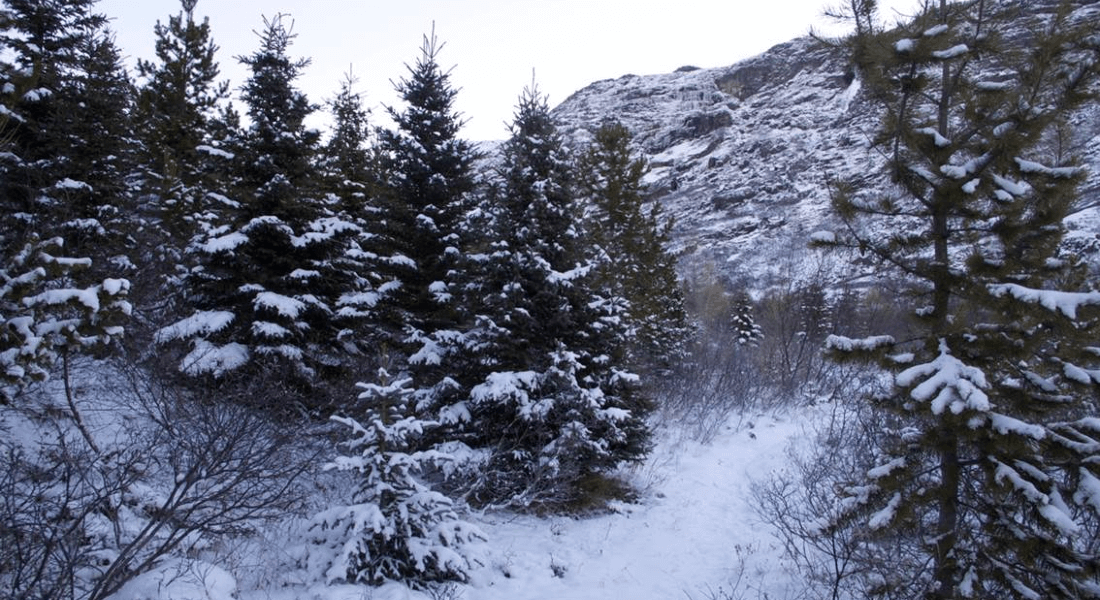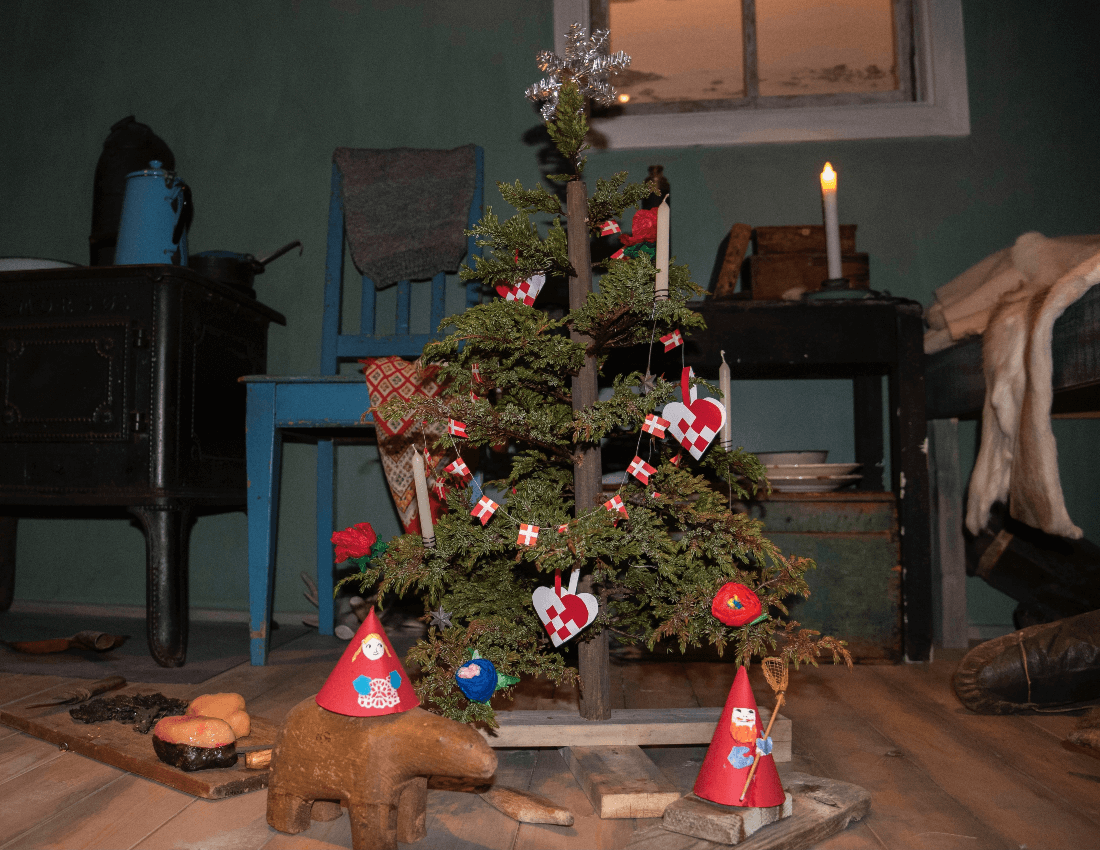Many, especially Danes, consider Greenland the home of Father Christmas. However for the most part, Greenland is Arctic tundra devoid of trees over knee height. So for Christmas, Greenlanders make do with imported trees or inventive substitutes. But nearly 5,000 Christmas trees now grow in South Greenland, planted by the University of Copenhagen and other curious botanists.

Your boughs, so green in Summertime
Stay bravely green in Wintertime
O Tannenbaum, O Christmas tree
How lovely are thy branches
This yuletide verse, known throughout the Christmas-celebrating world, is but one of many in which Christmas trees are revered. Though it is one of Christmas' most powerful symbols, not everyone gets to sing and dance around a Christmas tree of their own.
Ever since Greenland embraced the tradition, trees have been imported from Denmark or made using creative substitutes around which families gather on Christmas Eve. In the future, Greenlanders may well enjoy homegrown Christmas trees, which have begun to thrive in South Greenland over the past 50 years.
As a child, Associate Professor Anders Ræbild grew up raising Christmas trees on his father's and uncle's plantations in North Jutland. Today, his research focus is on multipurpose tree species.
"My uncle delivered Christmas trees to Greenland. It was funny because they were felled in August. The trees were felled, readied and then transported to Aalborg and placed in refrigerated containers for the voyage north," says Ræbild.
Now, as part of the University of Copenhagen's Department of Geosciences and Natural Resource Management, he has been associated with Denmark's Hørsholm Arboretum and a sister plantation forest in Narsarsuaq, South Greenland. An arboretum is a botanical collection of trees from around the world, where trees can be bred and researched.
The Greenlandic Arboretum in Narsarsuaq
The Arboretum in Narsarsuaq is one of the most extensive tree-line arboreta in the world, comprising about 150 hectares with about 110 species and about 600 provenances of trees and bushes.
The Arboretum was officially inaugurated in August 2004 and seeks to investigate whether tree-line tree and bush species from other regions can grow in Greenland.
The arboretum mainly contains trees from alpine and arctic tree-line areas of Europe, North America and Asia.
The first plantings in Narsarsuaq took place in the late 1960s. As of 2013, the trees in the collection have been registered. Select trees are marked with aluminum signs and GPS coordinates.
Today, the arboretum contains roughly 140,000 trees. 1300 have been identified and registered.
This is where Ræbild participated in research on so-called tree-line species - the northernmost growing trees in the northern hemisphere, specimens of which have been planted in Narsarsuaq for more than 100 years. Today, the plantation forest contains around 140,000 trees, including Christmas trees.
"As far as we can see, Greenland can now produce their own Christmas trees, despite the fact that they grow slowly. It may take 20 years to produce a tree that can be used. So, there are currently about 5,000 trees in Narsarsuaq that would be suitable as Christmas trees," says Ræbild, who hastens to add:
"But we would be terribly sorry if someone felled them. They are still very important for our research."
Huge potential for forests in Greenland
Why more trees do not grow in South Greenland is still a bit of a mystery as large spruce forests are found at similar latitudes across the planet. Except for a few scattered areas with knee-high birch trees, the area had no actual trees until the first specimens were planted by Europeans in the 1800s.
"Narsarsuaq is located at about the same latitude as Bergen, Norway, where forest grows for another 1000 kilometers further north - as is the case in many places worldwide. Thus, the paucity of natural tree species in southern Greenland is distinct compared to the abundance of species in North America, Europe and Asia at similar latitudes," says the tree scientist.
One focal area of research at the arboretum has therefore been to learn more about which trees can survive in the Greenlandic climate and why trees aren't found in Greenland.
"While some types of trees have had a hard time, due for example, to Foehn winds that shoot warm air down through the valleys and trick trees into believing that spring has arrived, the main conclusion is that there is a huge potential for forests in Greenland. The absence of forest for many thousands of years is most likely due to the ice ages, which, as they did in Europe, pushed tree ranges southwards. The difference in Greenland is that the ice sheet eventually pushed them into the ocean," says the researcher.
Christmas in Greenland with "homemade trees".
Silver fir is one variety that thrives and provides a reason to hope for the coming of Greenlandic Christmas trees in the future. And there may even be a business in it.
"The potential is there if Greenland wants to produce its own Christmas trees. Of course, it will require a few permits to get started, as the trees aren't native. Then there are the considerations of Greenlanders, whether to plant forests in the south, or maybe just in a few designated plantations. The mountains and fjords make it relatively simple to control how much tree populations spread, as we have done with the arboretum," he explains.
Ever since the Christmas tree tradition came to Greenland in the late 1800s, Greenlanders and Danes who settled there have learned to get by with the means at hand - imported trees, plastic ones in recent times and not least, "orpiliaq", i.e., homemade trees. Orpiliaq is also the word for Christmas tree in Greenland.
The country's only naturally occurring conifer is the juniper bush. Combined with a broom handle with holes in it, families without the opportunity to buy imported trees have resorted to juniper branches, moss and other ornamental greenery for their own inventive homemade Christmas trees.
Whether Greenland wants homemade or home-grown Christmas trees can therefore also become a question of traditions.
Imported trees and broomsticks decked with ornamental foliage

Here from a Christmas calendar by the Royal House of Denmark.
Photo: The Royal House
The Christmas tree tradition began in Germany in the 1700s. It first appeared in Denmark in the early 1800s, reaching Greenland at the end of the same century.
Since then, the Christmas tree has become an important symbol of Christmas in Greenland. But with juniper bushes being the only local evergreen, it has taken some ingenuity to put gifts under a local tree.
The Greenlandic word for Christmas tree, orpiliaq, means (home-) made wood and refers to inventive solutions:
- Holes are drilled in a broomstick or a large branch in strategic locations
- Juniper twigs are then placed in the holes
- From there, the tree is decorated just like any other.
Today, imported Christmas trees are the norm, along with plastic trees.
Christmas in the arboretum
The Greenlandic Arboretum in Narsarsuaq is now a tourist attraction and can be visited freely. If you don't have the chance to visit the arboretum in Narsarsuaq and see the trees for yourself, you can visit the Danish arboretum in Hørsholm, where many of the same varieties are grown.
On 17 December, Ole Kim Hansen from the University of Copenhagen will show trees and shrubs associated with Christmas, and talk about the research into Christmas trees. In addition to the tour, which is aimed at adults and lasts an hour and a half, there is a Christmas event for small sprouts and their families at the event.






